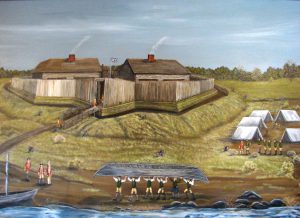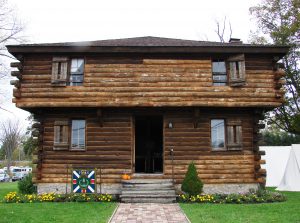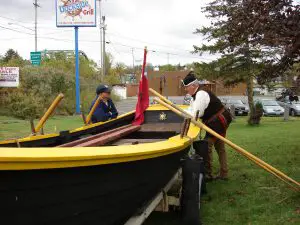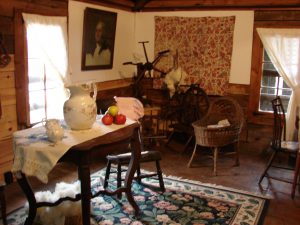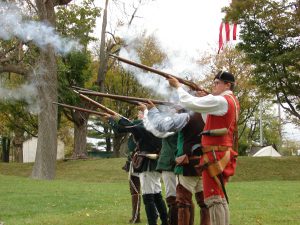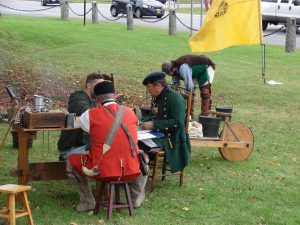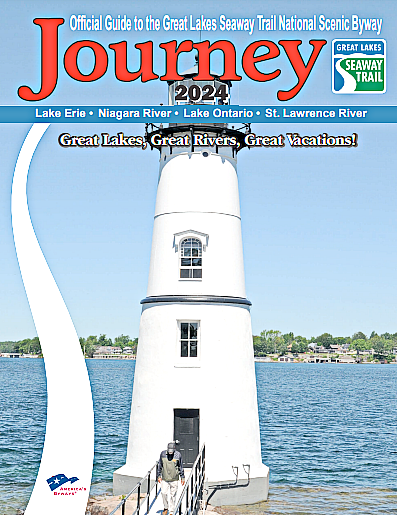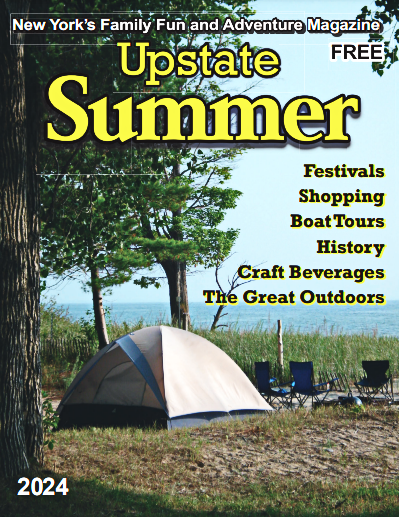- + ABOUT UPSTATE
- + THINGS TO DO
- + LODGING
- + WINE & DINE
- + DAY TRIPS
- + EVENTS
- + MAPS
- + TRAVEL BLOGS & MORE
- Site Search
Unlock The Secrets Of The Oliver Stevens Blockhouse
posted by Sandra Scott at 2017-10-27 14:14:00
Sandra Scott Travels: Unlock The Secrets Of The Oliver Stevens
Blockhouse
What is a block house?
A small wooden fortification.
For years, John and I have been driving by the Oliver Stevens Blockhouse on Route 11 in Brewerton.
It wasn’t until recently that I was able to visit the interior.
Luckily, I saw an announcement in the local media about their two-day event with a Revolutionary War encampment.
Fort Brewerton was built where Oneida Lake and the confluence of the Oneida River and Oswego River meet.
Before the canals were built rapids necessitated a portage between the waterways.
When Fort Brewerton was built by the British in 1759 there were four log blockhouses protected by five-foot earthworks and a moat plus a palisade of wooden logs.
It was to defend the passage between Albany and Oswego.
Sometimes we think we live in times that are more dangerous than the “Good Old Days.”
But, that is not always the case.
The people who lived in the Oswego County area in the 17 and 18 hundreds had many peaceful days, but were always aware of the dangers that could happen.
In 1789 Oliver and Nancy Stevens moved from Connecticut to the fort.
They are considered the first non-native settlers in the area.
They raised their six children there.
I am sure they tried to keep the children within the safety of the fort but they must have worried about many the same things that parents do today: diseases, injuries, and wandering beyond parent-set boundaries where kidnapping by native groups was not unusual, and there were wild animals.
As more and more settlers moved into the area they built canals connecting the waterways to Oneida Lake which facilitated travel thus eliminating the Oneida Carry.
The Erie Canal that was completed in 1825 bypassed Oneida Lake changing the travel patterns so the area didn’t grow as fast as it could have.
The walkway to the blockhouse is lined with honor bricks of supporters.
The windows have narrow slits that are called Loopholes.
The loophole let in the light, but also allowed small arms to be fired in relative safety.
The lower level had served as a trading post and today it has several displays and a map of what the area looked like in the 1700s.
Upstairs, where the family lived, has something of interest to just about everyone.
There is a great display of Native American artifacts found locally.
The docent said that Denman’s Island in Oneida Lake must have been a camping ground for Native Americans because many artifacts have been found there.
In 1965 a group of five students accompanied by three teachers from Lowville Academy unearthed Native American pottery that was at least 1,000 years old.
They also unearthed two graves and other relics that may be as old as 6,000 years.
It was all pre-European contact which made the find even more significant.
Besides Native American displays there are some that tell about the area from the time of Champlain to local veterans.
The museum has an extensive archive available to those doing research.
The Blockhouse is on the National Register of Historic Places.
The Revolutionary War encampment was setup by Schroth’s New York Company of the Jaegers’ Battalion – Rogers’ Raiders.
It was complete with tents, cooking area, camp command table, and other artifacts germane to the time period.
They put on several marching/firing demonstrations.
A smaller version of a bateau was on display.
The flat bottomed boat was mainly used to carry people and cargo on the rivers.
It was a great two-day event.
Sandra and her husband, John, have been exploring the world for decades, always on the lookout for something new and unique to experience. We have sailed down the Nile for a week on a felucca, stayed with the Pesch Indians in La Mosquitia, visited schools in a variety of countries, and — to add balance to our life — stayed at some of the most luxurious hotels in the world. Let the fun continue!
posted at: 2017-10-27 14:14:00, last updated: 2021-04-06 14:35:55











